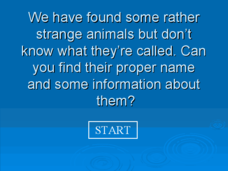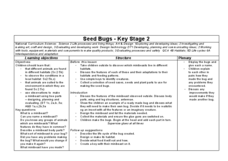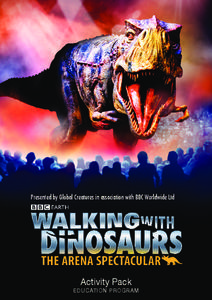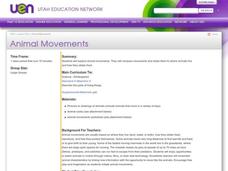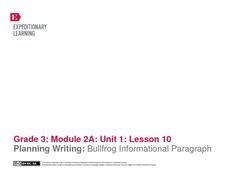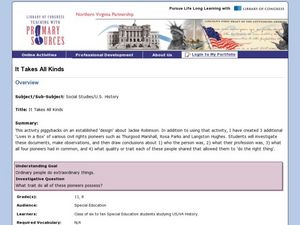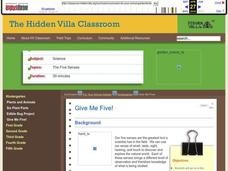Curated OER
Animal Coverings
Students read a book. In this animal characteristics instructional activity, students read the book Animal Coverings, answer comprehension questions, and complete a chart where they match animals with their coverings.
Curated OER
Classify Animals
Give your class an idea of how animals are classified by scientists with this interactive PowerPoint activity. They are presented with six different animals, they answer yes or no questions until only one animal remains alongside...
Curated OER
Investigation: Reasoning and Proof
Students explore animal characteristics by creating illustrations. In this animal identification lesson, students read a list of animal descriptions which they draw using crayons or colored pencils. Students view their drawings and...
Curated OER
Animal Classifications
Third graders work in small groups to investigate how to sort a variety of items into groups and subgroups. They work on a class chart based on the activity which show how the items are classified based on commonalities. Upon completion...
MENSA Education & Research Foundation
Kingdom Animalia: Classifying Animals
Six lessons, extension activities, and an assessment make up a series of lessons curated to reinforce the concept of classifying animals. Each informative and interactive lesson plan attributes to the knowledge of the seven levels of...
Curated OER
Classification of Animals
Students explore animal characteristics by participating in a SMART board activity. In this animal classification instructional activity, students utilize a sorting chart to divide different animal names by their observable...
Curated OER
Animal Classification
Students recognize the six groups of animals (Mammals, fish, birds, reptiles, amphibians and arthropods) and their characteristics. In this animal characteristics lesson, students sort animals by their traits. Students cut...
Curated OER
A Planet Full of Animals
Students study animals and practice classifying them through observation activities. In this animal classification instructional activity, students complete a KWL chart about animals. Students then sort pictures of animals into chart...
Alabama Wildlife Federation
Fill the Bill
A hummingbird isn't the only bird with a unique beak. After a discussion about the specific characteristics of bird beaks, pupils complete a station rotation and use different tools to simulate the function of different beaks. They...
Curated OER
An Introduction to Acids and Bases
Students explore acids and bases. In this lesson about acids and bases, students do an experiment to test certain items to determine what they are. Students use cabbage and litmus paper as indicators. Students understand how to sort the...
Curated OER
Animal Movements
Learners discuss the behavior of different animals and how they move. They explore the ways that this helps them live and find food in their environment. They participate in a game that requires them to mimic the ways in which animals move.
Curated OER
Seed Bugs; Stage 2
Students examine nature by participating in an environmental art activity. In this imaginary creature lesson, students discuss the importance of a habitat when pertaining to wild animals or bugs. Students utilize tree parts which they...
Curated OER
Sea Animal Slide Show
Students cllassify sea animals into groups based on certain attributes. They create a picture on ClarisWorks for Kids. They write/wordprocess their own name and copy words from immediate environment to label sea animals.
BBC
Walking with Dinosaurs
Breath new life into your class's study of dinosaurs with this extensive collection of materials. Offering everything from a printable T-rex mask, word searches, and connect-the-dots activities to informational handouts, hands-on...
Curated OER
Animal Movements
Students will explore animal movements. They will compare movements and relate them to where animals live and how they obtain food.
Curated OER
Science: Teddy Bear Nation
Students sort teddy bears according to types and then graph the results. They each bring a bear to class and then discuss their similarities and differences. Once the bears have been sorted into groups according to size and color,...
Curated OER
Big Bones, Little Bones
Learners investigate archeology. In this archeology instructional activity, students research the process of excavation. Learners participate in a mock-excavation and sort objects by physical properties.
EngageNY
Planning Writing: Bullfrog Information Paragraph
Lesson ten in this unit for the book Bullfrogs at Magnolia Circle, prepares third graders to begin writing an informational paragraph about the adaptations of bullfrogs. First, young writers work either independently or in pairs to...
Curated OER
Insects!
Students explore the diet of insects. In this "insects" biology lesson, students take a nature walk and collect various natural materials they think may be eaten by insects. Students sort and classify these materials into three diet...
Curated OER
The Way Animals Move: Fly, Crawl, or Swim?
Students use "Kid Pix" to stamp and sort animals in groups to show the way animals move: fly, walk-slither-slide-crawl, or swim. They need to have knowledge of a variety of animals and how they move from one place to another.
Curated OER
Exploring Zoo Animals
Students research topics related to zoos and zoo animals. They compare and contrast the size of animals, make a book of facts about bears, draw snakes, and write animal stories and poetry. They complete a series of writing and creative...
Curated OER
It Takes All Kinds!
Young scholars view video clips and observe similarities and differences between animals. They sort animals into groups for a zoo. They make a graph of their observations and review scientific classifications.
Curated OER
What's Hatching in Kindergarten?
Students identify oviparous animals. They brainstorm a list of animals that lay eggs, read "Chickens Aren't The Only Ones" by Ruth Heller and then add to the list. Students complete a booklet that shows an egg and an oviparous animal.
Curated OER
Give Me Five!
Students become familiar with their five senses and how their experiences would change without them. In this observations lesson, students observe using their five senses in a garden. Students illustrate what they've observed...

